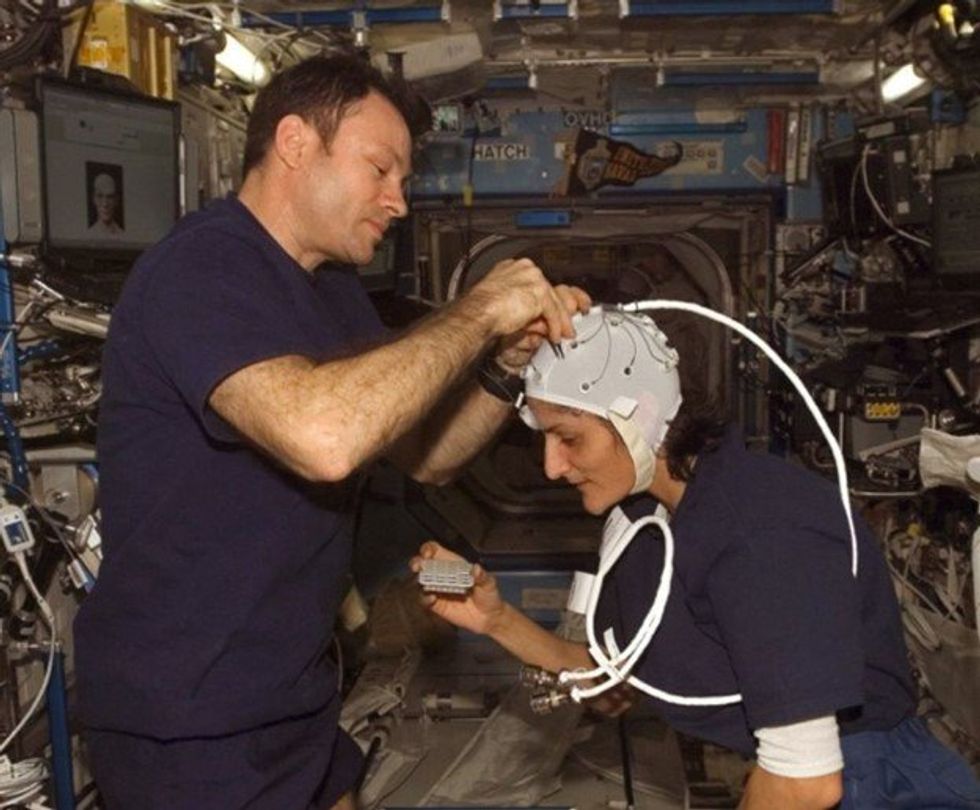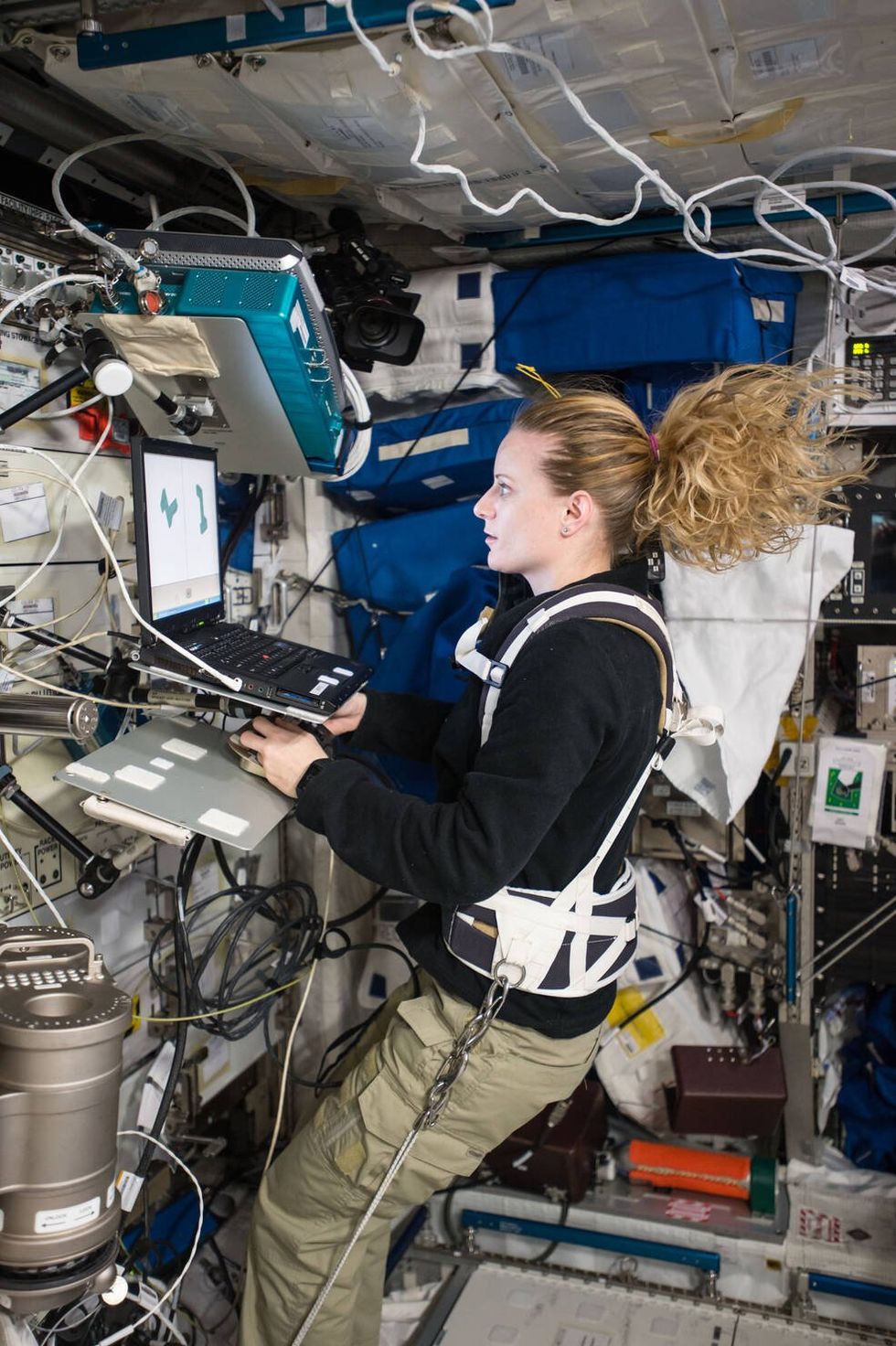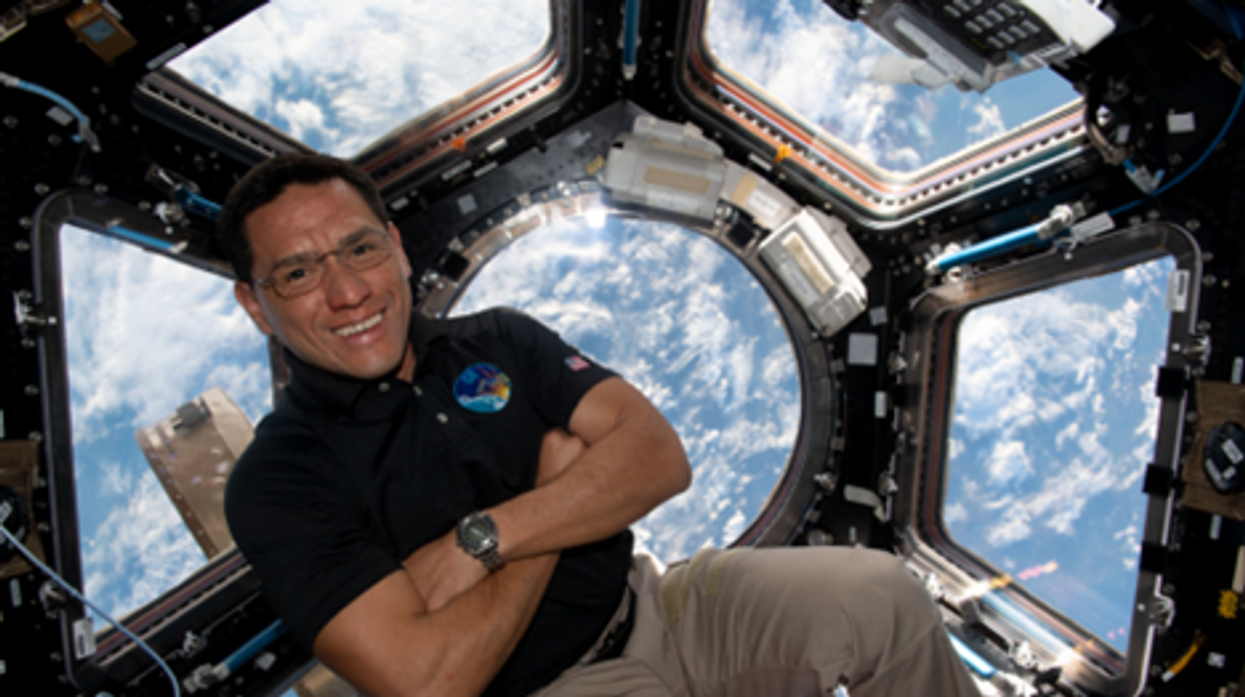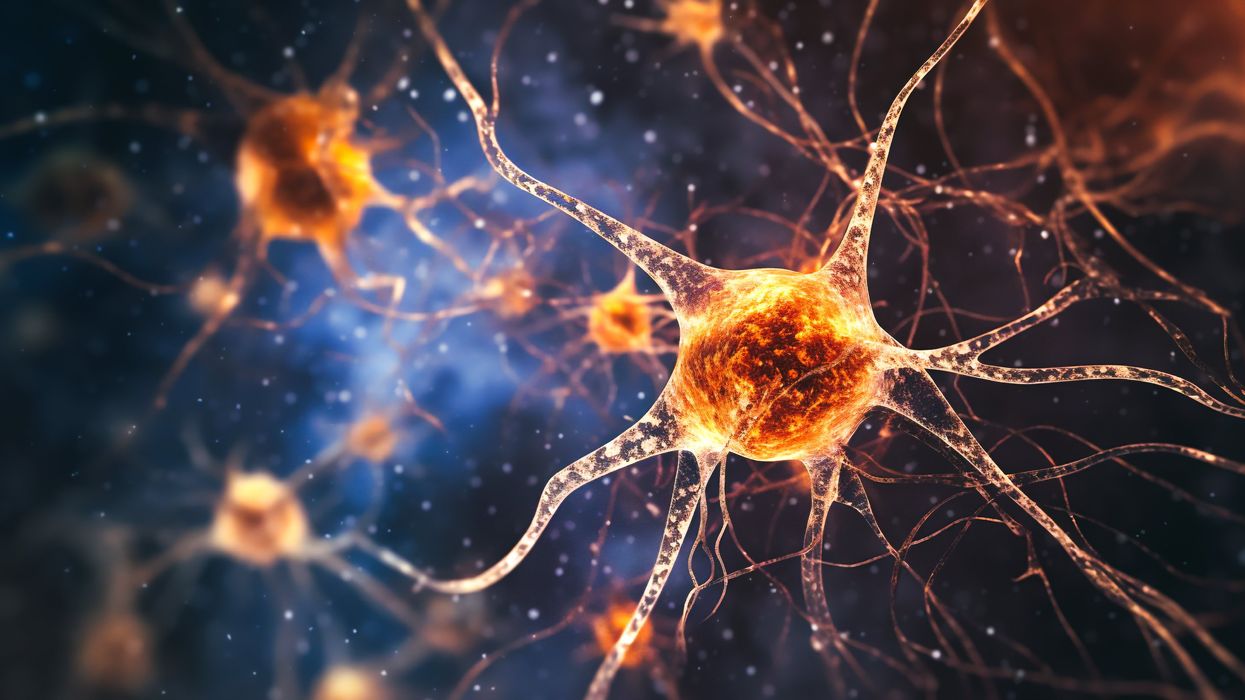Science Fact vs. Science Fiction: Can You Tell the Difference?

A portrait of skepticism while reading information online.
Today's growing distrust of science is not an academic problem. It can be a matter of life and death.
Take, for example, the tragic incident in 2016 when at least 10 U.S. children died and over 400 were sickened after they tried homeopathic teething medicine laced with a poisonous herb called "deadly nightshade." Carried by CVS, Walgreens, and other major American pharmacies, the pills contained this poison based on the alternative medicine principle of homeopathy, the treatment of medical conditions by tiny doses of natural substances that produce symptoms of disease.
Such "alternative medicines" take advantage of the lack of government regulation and people's increasing hostility toward science.
These children did not have to die. Numerous research studies show that homeopathy does not work. Despite this research, homeopathy is a quickly-growing multi-billion dollar business.
Such "alternative medicines" take advantage of the lack of government regulation and people's increasing hostility toward science. Polling shows that the number of people who believe that science has "made life more difficult" increased by 50 percent from 2009 to 2015. According to a 2017 survey, only 35 percent of respondents have "a lot" of trust in scientists; the number of people who do "not at all" trust scientists increased by over 50 percent from a similar poll conducted in December 2013.
Children dying from deadly nightshade is only one consequence of this crisis of trust. For another example, consider the false claim that vaccines cause autism. This belief has spread widely across the US, and led to a host of problems. For instance, measles was practically eliminated in the US by 2000. However, in recent years outbreaks of measles have been on the rise, driven by parents failing to vaccinate their children in a number of communities.
The Internet Is for… Misinformation
The rise of the Internet, and more recently social media, is key to explaining the declining public confidence in science.
Before the Internet, the information accessible to the general public about any given topic usually came from experts. For instance, researchers on autism were invited to talk on mainstream media, they wrote encyclopedia articles, and they authored books distributed by large publishers.
The Internet has enabled anyone to be a publisher of content, connecting people around the world with any and all sources of information. On the one hand, this freedom is empowering and liberating, with Wikipedia a great example of a highly-curated and accurate source on the vast majority of subjects. On the other, anyone can publish a blog piece making false claims about links between vaccines and autism or the effectiveness of homeopathic medicine. If they are skilled at search engine optimization, or have money to invest in advertising, they can get their message spread widely. Russia has done so extensively to influence elections outside of its borders, whether in the E.U. or the U.S.
Unfortunately, research shows that people lack the skills for differentiating misinformation from true information. This lack of skills has clear real-world effects: U.S. adults believed 75 percent of fake news stories about the 2016 US Presidential election. The more often someone sees a piece of misinformation, the more likely they are to believe it.
To make matters worse, we all suffer from a series of thinking errors such as the confirmation bias, our tendency to look for and interpret information in ways that conform to our intuitions.
Blogs with falsehoods are bad enough, but the rise of social media has made the situation even worse. Most people re-share news stories without reading the actual article, judging the quality of the story by the headline and image alone. No wonder research has indicated that misinformation spreads as much as 10 times faster and further on social media than true information. After all, creators of fake news are free to devise the most appealing headline and image, while credible sources of information have to stick to factual headlines and images.
To make matters worse, we all suffer from a series of thinking errors such as the confirmation bias, our tendency to look for and interpret information in ways that conform to our intuitions and preferences, as opposed to the facts. Our inherent thinking errors combined with the Internet's turbine power has exploded the prevalence of misinformation.
So it's no wonder we see troubling gaps between what scientists and the public believe about issues like climate change, evolution, genetically modified organisms, and vaccination.
What Can We Do?
Fortunately, there are proactive steps we can take to address the crisis of trust in science and academia. The Pro-Truth Pledge, founded by a group of behavioral science experts (including myself) and concerned citizens, calls on public figures, organizations, and private citizens to commit to 12 behaviors listed on the pledge website that research in behavioral science shows correlate with truthfulness.
Signers are held accountable through a crowdsourced reporting and evaluation mechanism while getting reputational rewards because of their commitment. The scientific consensus serves as a key measure of credibility, and the pledge encourages pledge-takers to recognize the opinions of experts - especially scientists - as more likely to be true when the facts are disputed.
The pledge "really does seem to change one's habits," encouraging signers to have attitudes "of honesty and moral sincerity."
Launched in December 2016, the pledge has surprising traction. Over 6200 private citizens took the pledge. So did more than 500 politicians, including members of US state legislatures Eric Nelson (PA), James White (TX), and Ogden Driskell (WY), and national politicians such as members of U.S. Congress Beto O'Rourke (TX), Matt Cartwright (PA), and Marcia Fudge (OH). Over 700 other public figures, such as globally-known public intellectuals Peter Singer, Steven Pinker, Michael Shermer, and Jonathan Haidt, took the pledge, as well as 70 organizations such as Media Bias/Fact Check, Fugitive Watch, Earth Organization for Sustainability, and One America Movement.
The pledge is effective in changing behaviors. A candidate for Congress, Michael Smith, took the Pro-Truth Pledge. He later posted on his Facebook wall a screenshot of a tweet by Donald Trump criticizing minority and disabled children. However, after being called out that the tweet was a fake, he went and searched Trump's feed. He could not find the original tweet, and while Trump may have deleted it, the candidate edited his own Facebook post to say, "Due to a Truth Pledge I have taken, I have to say I have not been able to verify this post." He indicated that he would be more careful with future postings.
U.S. Army veteran and pledge-taker John Kirbow described how the pledge "really does seem to change one's habits," helping push him both to correct his own mistakes with an "attitude of humility and skepticism, and of honesty and moral sincerity," and also to encourage "friends and peers to do so as well."
His experience is confirmed by research on the pledge. Two research studies at Ohio State University demonstrated the effectiveness of the pledge in changing the behavior of pledge-takers to be more truthful with a strong statistical significance.
Taking the pledge yourself, and encouraging people you know and your elected representatives to do the same, is an easy and effective way to fight misinformation and to promote a culture that values the truth.
After spaceflight record, NASA looks to protect astronauts on even longer trips
NASA astronaut Frank Rubio floats by the International Space Station’s “window to the world.” Yesterday, he returned from the longest single spaceflight by a U.S. astronaut on record - over one year. Exploring deep space will require even longer missions.
At T-minus six seconds, the main engines of the Atlantis Space Shuttle ignited, rattling its capsule “like a skyscraper in an earthquake,” according to astronaut Tom Jones, describing the 1988 launch. As the rocket lifted off and accelerated to three times the force of Earth's gravity, “It felt as if two of my friends were standing on my chest and wouldn’t get off.” But when Atlantis reached orbit, the main engines cut off, and the astronauts were suddenly weightless.
Since 1961, NASA has sent hundreds of astronauts into space while working to making their voyages safer and smoother. Yet, challenges remain. Weightlessness may look amusing when watched from Earth, but it has myriad effects on cognition, movement and other functions. When missions to space stretch to six months or longer, microgravity can impact astronauts’ health and performance, making it more difficult to operate their spacecraft.
Yesterday, NASA astronaut Frank Rubio returned to Earth after over one year, the longest single spaceflight for a U.S. astronaut. But this is just the start; longer and more complex missions into deep space loom ahead, from returning to the moon in 2025 to eventually sending humans to Mars. To ensure that these missions succeed, NASA is increasing efforts to study the biological effects and prevent harm.
The dangers of microgravity are real
A NASA report published in 2016 details a long list of incidents and near-misses caused – at least partly – by space-induced changes in astronauts’ vision and coordination. These issues make it harder to move with precision and to judge distance and velocity.
According to the report, in 1997, a resupply ship collided with the Mir space station, possibly because a crew member bumped into the commander during the final docking maneuver. This mishap caused significant damage to the space station.
Returns to Earth suffered from problems, too. The same report notes that touchdown speeds during the first 100 space shuttle landings were “outside acceptable limits. The fastest landing on record – 224 knots (258 miles) per hour – was linked to the commander’s momentary spatial disorientation.” Earlier, each of the six Apollo crews that landed on the moon had difficulty recognizing moon landmarks and estimating distances. For example, Apollo 15 landed in an unplanned area, ultimately straddling the rim of a five-foot deep crater on the moon, harming one of its engines.

Spaceflight causes unique stresses on astronauts’ brains and central nervous systems. NASA is working to reduce these harmful effects.
NASA
Space messes up your brain
In space, astronauts face the challenges of microgravity, ionizing radiation, social isolation, high workloads, altered circadian rhythms, monotony, confined living quarters and a high-risk environment. Among these issues, microgravity is one of the most consequential in terms of physiological changes. It changes the brain’s structure and its functioning, which can hurt astronauts’ performance.
The brain shifts upwards within the skull, displacing the cerebrospinal fluid, which reduces the brain’s cushioning. Essentially, the brain becomes crowded inside the skull like a pair of too-tight shoes.
That’s partly because of how being in space alters blood flow. On Earth, gravity pulls our blood and other internal fluids toward our feet, but our circulatory valves ensure that the fluids are evenly distributed throughout the body. In space, there’s not enough gravity to pull the fluids down, and they shift up, says Rachael D. Seidler, a physiologist specializing in spaceflight at the University of Florida and principal investigator on many space-related studies. The head swells and legs appear thinner, causing what astronauts call “puffy face chicken legs.”
“The brain changes at the structural and functional level,” says Steven Jillings, equilibrium and aerospace researcher at the University of Antwerp in Belgium. “The brain shifts upwards within the skull,” displacing the cerebrospinal fluid, which reduces the brain’s cushioning. Essentially, the brain becomes crowded inside the skull like a pair of too-tight shoes. Some of the displaced cerebrospinal fluid goes into cavities within the brain, called ventricles, enlarging them. “The remaining fluids pool near the chest and heart,” explains Jillings. After 12 consecutive months in space, one astronaut had a ventricle that was 25 percent larger than before the mission.
Some changes reverse themselves while others persist for a while. An example of a longer-lasting problem is spaceflight-induced neuro-ocular syndrome, which results in near-sightedness and pressure inside the skull. A study of approximately 300 astronauts shows near-sightedness affects about 60 percent of astronauts after long missions on the International Space Station (ISS) and more than 25 percent after spaceflights of only a few weeks.
Another long-term change could be the decreased ability of cerebrospinal fluid to clear waste products from the brain, Seidler says. That’s because compressing the brain also compresses its waste-removing glymphatic pathways, resulting in inflammation, vulnerability to injuries and worsening its overall health.
The effects of long space missions were best demonstrated on astronaut twins Scott and Mark Kelly. This NASA Twins Study showed multiple, perhaps permanent, changes in Scott after his 340-day mission aboard the ISS, compared to Mark, who remained on Earth. The differences included declines in Scott’s speed, accuracy and cognitive abilities that persisted longer than six months after returning to Earth in March 2016.
By the end of 2020, Scott’s cognitive abilities improved, but structural and physiological changes to his eyes still remained, he said in a BBC interview.
“It seems clear that the upward shift of the brain and compression of the surrounding tissues with ventricular expansion might not be a good thing,” Seidler says. “But, at this point, the long-term consequences to brain health and human performance are not really known.”

NASA astronaut Kate Rubins conducts a session for the Neuromapping investigation.
NASA
Staying sharp in space
To investigate how prolonged space travel affects the brain, NASA launched a new initiative called the Complement of Integrated Protocols for Human Exploration Research (CIPHER). “CIPHER investigates how long-duration spaceflight affects both brain structure and function,” says neurobehavioral scientist Mathias Basner at the University of Pennsylvania, a principal investigator for several NASA studies. “Through it, we can find out how the brain adapts to the spaceflight environment and how certain brain regions (behave) differently after – relative to before – the mission.”
To do this, he says, “Astronauts will perform NASA’s cognition test battery before, during and after six- to 12-month missions, and will also perform the same test battery in an MRI scanner before and after the mission. We have to make sure we better understand the functional consequences of spaceflight on the human brain before we can send humans safely to the moon and, especially, to Mars.”
As we go deeper into space, astronauts cognitive and physical functions will be even more important. “A trip to Mars will take about one year…and will introduce long communication delays,” Seidler says. “If you are on that mission and have a problem, it may take eight to 10 minutes for your message to reach mission control, and another eight to 10 minutes for the response to get back to you.” In an emergency situation, that may be too late for the response to matter.
“On a mission to Mars, astronauts will be exposed to stressors for unprecedented amounts of time,” Basner says. To counter them, NASA is considering the continuous use of artificial gravity during the journey, and Seidler is studying whether artificial gravity can reduce the harmful effects of microgravity. Some scientists are looking at precision brain stimulation as a way to improve memory and reduce anxiety due to prolonged exposure to radiation in space.
Other scientists are exploring how to protect neural stem cells (which create brain cells) from radiation damage, developing drugs to repair damaged brain cells and protect cells from radiation.
To boldly go where no astronauts have gone before, they must have optimal reflexes, vision and decision-making. In the era of deep space exploration, the brain—without a doubt—is the final frontier.
Additionally, NASA is scrutinizing each aspect of the mission, including astronaut exercise, nutrition and intellectual engagement. “We need to give astronauts meaningful work. We need to stimulate their sensory, cognitive and other systems appropriately,” Basner says, especially given their extreme confinement and isolation. The scientific experiments performed on the ISS – like studying how microgravity affects the ability of tissue to regenerate is a good example.
“We need to keep them engaged socially, too,” he continues. The ISS crew, for example, regularly broadcasts from space and answers prerecorded questions from students on Earth, and can engage with social media in real time. And, despite tight quarters, NASA is ensuring the crew capsule and living quarters on the moon or Mars include private space, which is critical for good mental health.
Exploring deep space builds on a foundation that began when astronauts first left the planet. With each mission, scientists learn more about spaceflight effects on astronauts’ bodies. NASA will be using these lessons to succeed with its plans to build science stations on the moon and, eventually, Mars.
“Through internally and externally led research, investigations implemented in space and in spaceflight simulations on Earth, we are striving to reduce the likelihood and potential impacts of neurostructural changes in future, extended spaceflight,” summarizes NASA scientist Alexandra Whitmire. To boldly go where no astronauts have gone before, they must have optimal reflexes, vision and decision-making. In the era of deep space exploration, the brain—without a doubt—is the final frontier.
A newly discovered brain cell may lead to better treatments for cognitive disorders
Swiss researchers have found a type of brain cell that appears to be a hybrid of the two other main types — and it could lead to new treatments for brain disorders.
Swiss researchers have discovered a third type of brain cell that appears to be a hybrid of the two other primary types — and it could lead to new treatments for many brain disorders.
The challenge: Most of the cells in the brain are either neurons or glial cells. While neurons use electrical and chemical signals to send messages to one another across small gaps called synapses, glial cells exist to support and protect neurons.
Astrocytes are a type of glial cell found near synapses. This close proximity to the place where brain signals are sent and received has led researchers to suspect that astrocytes might play an active role in the transmission of information inside the brain — a.k.a. “neurotransmission” — but no one has been able to prove the theory.
A new brain cell: Researchers at the Wyss Center for Bio and Neuroengineering and the University of Lausanne believe they’ve definitively proven that some astrocytes do actively participate in neurotransmission, making them a sort of hybrid of neurons and glial cells.
According to the researchers, this third type of brain cell, which they call a “glutamatergic astrocyte,” could offer a way to treat Alzheimer’s, Parkinson’s, and other disorders of the nervous system.
“Its discovery opens up immense research prospects,” said study co-director Andrea Volterra.
The study: Neurotransmission starts with a neuron releasing a chemical called a neurotransmitter, so the first thing the researchers did in their study was look at whether astrocytes can release the main neurotransmitter used by neurons: glutamate.
By analyzing astrocytes taken from the brains of mice, they discovered that certain astrocytes in the brain’s hippocampus did include the “molecular machinery” needed to excrete glutamate. They found evidence of the same machinery when they looked at datasets of human glial cells.
Finally, to demonstrate that these hybrid cells are actually playing a role in brain signaling, the researchers suppressed their ability to secrete glutamate in the brains of mice. This caused the rodents to experience memory problems.
“Our next studies will explore the potential protective role of this type of cell against memory impairment in Alzheimer’s disease, as well as its role in other regions and pathologies than those explored here,” said Andrea Volterra, University of Lausanne.
But why? The researchers aren’t sure why the brain needs glutamatergic astrocytes when it already has neurons, but Volterra suspects the hybrid brain cells may help with the distribution of signals — a single astrocyte can be in contact with thousands of synapses.
“Often, we have neuronal information that needs to spread to larger ensembles, and neurons are not very good for the coordination of this,” researcher Ludovic Telley told New Scientist.
Looking ahead: More research is needed to see how the new brain cell functions in people, but the discovery that it plays a role in memory in mice suggests it might be a worthwhile target for Alzheimer’s disease treatments.
The researchers also found evidence during their study that the cell might play a role in brain circuits linked to seizures and voluntary movements, meaning it’s also a new lead in the hunt for better epilepsy and Parkinson’s treatments.
“Our next studies will explore the potential protective role of this type of cell against memory impairment in Alzheimer’s disease, as well as its role in other regions and pathologies than those explored here,” said Volterra.

This article originally appeared on Freethink, home of the brightest minds and biggest ideas of all time.

